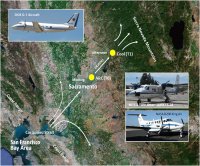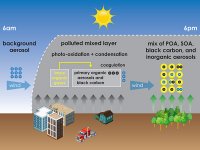Atmospher Sci & Global Chg
Research Highlights
August 2012
A Chemistry Tale of Two Carbons
Comprehensive field study of urban and natural emissions interacting to affect climate change

The CARES field campaign was centered on Sacramento, California. The yellow dots indicate the locations of the two ground supersites: one in the Sacramento urban area (T0) and the other in the rural foothills area (T1) rich in natural hydrocarbon emissions. The DOE G-1 and NASA B200 King Air aircraft were integral to the CARES campaign for collecting data aloft over a larger domain. The arrows indicate the typical daytime wind flow pattern in the region during summer. Enlarge Image

The CARES field campaign was designed to increase scientific knowledge about the evolution of black carbon, primary organic aerosols (POA), and secondary organic aerosols (SOA) from both human-caused and natural (biogenic) sources. Black carbon and primary organic aerosols are emitted directly into the atmosphere through vehicle exhaust, meat cooking, and biomass burning. Secondary organic aerosols are formed through complex physical and chemical interactions between pre-existing aerosols in the atmosphere and trace organic gases emitted from both human-caused and natural sources. Illustration adapted from the ARM Climate Research Facility. Enlarge Image
Results: City carbons and country carbons regularly mix in the atmosphere, but how do they get along? That is essentially the question being tackled by a team of scientists led by researchers at Pacific Northwest National Laboratory. In the 2010 Carbonaceous Aerosols and Radiative Effects Study (CARES) research campaign they amassed a rich data set that will shed light on key science questions: how do these carbons meet, mix, travel, grow old, and affect the Earth's climate? The scientific overview of the field research was published in Atmospheric Chemistry and Physics in August 2012.
Why It Matters: Carbon-containing, or "carbonaceous," aerosols are microscopic, solid or liquid particles dispersed in the atmosphere, and they can originate from both natural and human-caused sources. They affect the Earth's climate by influencing how clouds form and by absorbing or reflecting the sun's energy. The phrase "carbonaceous aerosol emissions" invites a mental picture of black exhaust spewing from a diesel truck or industrial smoke stack. These sources of soot, a.k.a. black carbon, are easily pictured. But other types of carbonaceous aerosols originate from natural, or biogenic, sources as part of natural processes. As vegetation and forests grow, decay, and in some cases burn, many different gases and aerosol particles are released into the atmosphere.
Understanding what happens when the carbon-containing emissions from human activities, such as transportation and industry, mix and chemically interact with those from natural sources will help provide a better representation of their radiative energy effects in climate models. The carbon bits in this study have a tale to tell. Understanding their story is important because escalating emissions of carbon-containing aerosols around the world from increasing fossil fuel burning, biomass burning, and wildfires have far-reaching impacts on Earth's climate.
Methods: In June 2010, a team of scientists led by researchers at PNNL conducted an intensive aircraft and ground-based field study in and around Sacramento, California, where they measured carbonaceous aerosols and their precursors from both natural and human-caused sources. This sampling location was selected for its unique summertime meteorology. During this time, urban emissions from the San Francisco Bay Area sweep into the Central Valley with onshore winds and pick up additional emissions from Sacramento. The plume of urban emissions then flows into the Sierra Nevada Mountains where it mixes and interacts with natural aerosols and their precursors emitted from forests.
Laying the groundwork for future analyses, the scientists identified three observation periods when the aerosols in the sampling area were impacted by natural emissions only, urban emissions only, and when both types of emissions mixed together. The measurements were focused on primary aerosols such as black carbon that are directly emitted into the atmosphere as well as aerosols that are formed in the atmosphere called secondary organic aerosols and their climate-related properties.
In the first of many studies to follow, this research paper presents the scientific overview of the CARES field campaign and provides a roadmap of future data analyses and modeling studies of the complex interactions between the urban and natural carbonaceous aerosols. Data from the campaign have been uploaded to the U.S. DOE's Atmospheric Radiation Measurement (ARM) Climate Research Facility's data archive for future studies by the science community.
What's Next? The research team has laid out a roadmap for data analysis that will help improve and evaluate various aerosol processes and properties modules, which feed into regional and global climate models.
Acknowledgments: This research was supported by the U.S. Department of Energy's (DOE's) Office of Science, Biological and Environmental Research (OBER) Atmospheric System Research program. Funding for data collection onboard the G-1 aircraft and at the ground sites was provided by the ARM program sponsored by OBER, Climate and Environmental Sciences Division. Partial support was provided by the Environmental Molecular Sciences Laboratory (EMSL), a national scientific user facility sponsored by the DOE's OBER and located at Pacific Northwest National Laboratory.
Reference: Zaveri RA, WJ Shaw, DJ Cziczo, B Schmid, RA Ferrare, ML Alexander, M Alexandrov, RJ Alvarez, WP Arnott, DB Atkinson, S Baidar, RM Banta, JC Barnard, J Beranek, LK Berg, F Brechtel, WA Brewer, JF Cahill, B Cairns, CD Cappa, D Chand, S China, JM Comstock, MK Dubey, RC Easter, MH Erickson, JD Fast, C Floerchinger, BA Flowers, E Fortner, JS Gaffney, MK Gilles, K Gorkowski, WI Gustafson, M Gyawali, J Hair, RM Hardesty, JW Harworth, S Herndon, N Hiranuma, C Hostetler, JM Hubbe, JT Jayne, H Jeong, BT Jobson, EI Kassianov, LI Kleinman, C Kluzek, B Knighton, KR Kolesar, C Kuang, A Kubátová, AO Langford, A Laskin, N Laulainen, RD Marchbanks, C Mazzoleni, F Mei, RC Moffet, D Nelson, MD Obland, H Oetjen, TB Onasch, I Ortega, M Ottaviani, M Pekour, KA Prather, JG Radney, RR Rogers, SP Sandberg, A Sedlacek, CJ Senff, G Senum, A Setyan, JE Shilling, M Shrivastava, C Song, SR Springston, R Subramanian, K Suski, J Tomlinson, R Volkamer, HW Wallace, J Wang, AM Weickmann, DR Worsnop, XY Yu, A Zelenyuk, and Q Zhang. 2012. "Overview of the 2010 Carbonaceous Aerosols and Radiative Effects Study (CARES)." Atmospheric Chemistry and Physics 12(16):7647-7687. DOI:10.5194/acp-12-7647-2012.
